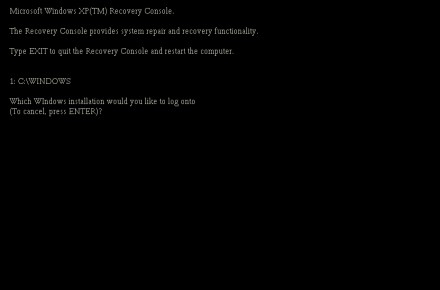

- USE WINDOWS RECOVERY CONSOLE XP INSTALL
- USE WINDOWS RECOVERY CONSOLE XP FULL
- USE WINDOWS RECOVERY CONSOLE XP PASSWORD
It’s important to note that your cdrom version of XP has to match the version of XP that you have installed. First you’ll need to insert your Windows XP cdrom into the drive. You will see all Resore Check points created till date. Installing Recovery Console to the Hard Drive. Now type ' cd resto1 ' press enter and type ' dir ' (to see all dirctories and files). Type ' cd c:\system1 ' (Trying to Access System Volume Information). Use the help switch with the chkdsk command to show detailed help about the commands listed above and other options you can use with chkdsk. Again boot from the Windows Xp Cd and select repair menu. This chkdsk option dismounts the volume only briefly in order to fix issues that were sent to the log file. This is true for both internal and external hard drives you can continue using them throughout the course of the scan. Here, "online" means that the volume does not need to be dismounted, but can instead remain online/active. This chkdsk option runs an online scan on an NTFS volume but does not try to repair it. This option allows chkdsk to run faster by using more system resources. When it asks which Windows installation you want. The default log file size for chkdsk is 65536 KB you can check the current log file size by executing /L without the "size" option. To start the Recovery Console, boot your computer from the Windows XP installation CD and follow the prompts. Use this chkdsk command option to change the size (in KB) of the log file. Same as /I but skips over cycles within the folder structure to reduce the amount of time that the chkdsk command runs. This option will perform a less vigorous chkdsk command by instructing the command to run faster by skipping over certain regular checks. This command option implies /F and will force a dismount of the volume if necessary. This option implies /F when /scan is not specified. This option tells chkdsk to locate bad sectors and recover any readable information from them. If used on an NTFS volume, it will show cleanup messages (if there are any).
USE WINDOWS RECOVERY CONSOLE XP FULL
Use this chkdsk option on a FAT or FAT32 volume to show the full path and name of every file on the disk. This chkdsk command option will fix any errors found on the disk. Installing the program on an XP computer creates erd50.iso in the following folder.This is the drive letter of the partition for which you want to check for errors. You will have to use two extraction methods. If one isn't available the erd50.iso file can be extracted with a program called Universal extractor.
USE WINDOWS RECOVERY CONSOLE XP INSTALL
You will have to install this on a XP computer as I believe it will not install on Vista or Windows 7. When you use Windows XP Professional, you can set.
USE WINDOWS RECOVERY CONSOLE XP PASSWORD
You will have to use two extraction methods. After you enter your password and the Windows Recovery Console starts, type exit to restart the computer. It provides the means for administrators to perform a limited range of tasks using a command-line interface.Its primary function is to enable administrators to recover from situations where Windows does not boot as far as presenting its graphical user interface. If one isn't available the erd50.iso file can be extracted with a program called Universal extractor. The Recovery Console is a feature of the Windows 2000, Windows XP and Windows Server 2003 operating systems. The site is German but the program is english. To run the Recovery Console from the Windows XP startup disks or the Windows XP CD-ROM, follow these steps: 1. If ERD 2007 removes the config/system error than you may be able to repair the second problem with recovery console.ĭownload the following file which includes erd 2007. If doing a system restore does not work with ERD 2007 then you may be looking at a repair install. Fixing the first may resolve the second but I am not sure. The second may be do to several problems including a missing file or bad boot.ini file. It will allow you to do a system restore if you have restore points available.

Because Last Know Good Configuration did not work, I am not sure if the following will help or not. The first error is due to a bad or missing hive.


 0 kommentar(er)
0 kommentar(er)
